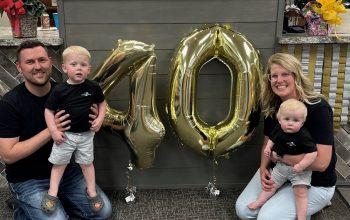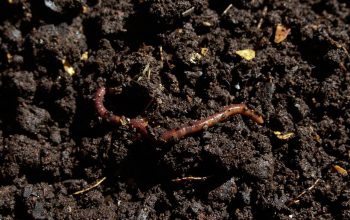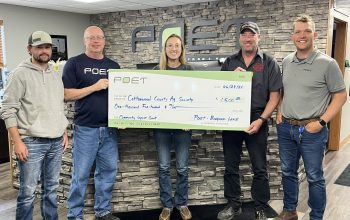Part 1 of 2
Abi Aswegen of Belmond calls herself a “Bonus Mom” instead of a foster mom to the children she and her husband, Caleb, have welcomed into their home since first becoming foster parents. The Aswegens have been a licensed foster family just over a year and a half…but it’s been in Abi’s heart to do so for many years before now.
Abi grew up in Wisconsin and is from a town of about 2,000 people. She describes it as a friendly place like many people might say about their own hometowns, but she also describes it as adoption-friendly. That’s because out of the 90 students in Abi’s graduating class, about five of them were adopted. In addition, several of her high school teachers adopted children, as did people in her church, who not only adopted but fostered children as well.
“It was very normal for me, so I just grew up thinking that’s what you do. You help people and you help families. Certainly everyone wants to adopt,” she remembers thinking.
When she met Caleb, she said she talked with him from the very beginning about someday being able to foster children. Eventually, they got married, had a son of their own (who is now five), and settled in their current home about three years ago. That’s when she said they just knew it was the right time to pursue their dream of providing a loving, safe home to children who needed it by becoming foster parents. After 10 weeks of classes and training, they were ready to begin their journey.
Their first foster child was a little boy who they cared for for about six months. Abi admits it was hard to say goodbye. It was an emotional time for them and took several months to adjust back to life without him being part of their family. To help their own son adjust to the foster child being gone, Abi said they did a lot of reading. One book, in particular, was very helpful – “The One and Only Ivan.” It tells the story of a gorilla who lived in a cage at a roadside mall who eventually gave his favorite stuffed animal, Tag, to his friend the dog when they were to be separated.
“Stuffies were a big thing for our first foster child, too,” said Abi.
“We explained to our son that we were our foster son’s “roadside mall” just like in the book…it was a safe place for him to be but not the best place for him to be,” said Abi. “That really helped all of us adjust.”
They also remind their son that just because they don’t live together anymore, it doesn’t mean they can’t continue to have a relationship with him. They still pray for him, occasionally see him, and send pictures and postcards.
In December of 2020, they started the fostering journey again when they welcomed into their home two sisters, ages 10 and 11.
“Our son absolutely loves it. We’ve always joked that he has the personality of the youngest child…he absolutely loves being the youngest and having big sisters now,” said Abi. “When he found out about the placement, he went to school and told everybody that he was getting sisters. He was so excited.”
In addition to having always wanted to be a foster parent, and possibly an adoptive parent, Abi has worked in the past as a social worker.
“So I know the foster care world really well,” she said, but admits that actually becoming a foster parent made her see the process a little differently. “It’s not as much about what you know about foster care as it is about knowing yourselves – what your personalities are and your own family dynamics, what you can do and what you can’t…to do what’s best for everyone.”
That includes, unfortunately, sometimes having to say “no” to placements – not because they don’t want the children, but because they might not be the best fit for the child’s needs, might not have enough room, or have enough internal reserves considering what is currently going on in their home, with their children and placements at the moment. In a two-week timeframe, for example, the Aswegen family was contacted 11 times to take in more children. While their hearts had room, their house and their car just did not. Be that as it may, the need for foster parents in our area is significant. The phone calls will continue to come, and the Aswegens will continue to evaluate each call as it comes, carefully considering when to say the next “yes.”
In the meantime, with their current placements, Abi and Caleb always try to make sure their “bonus children” feel like they fit into their family. One way of doing this is making a conscious effort to not refer to them as “foster children.”
“Child of mine,” is one of my favorite phrases to use,” said Abi of how she refers to them instead.
She also introduces them as her daughters or children. When someone says “They must look like your husband,” she responds, “Oh, they look like their dad” and leaves it at that.
If someone makes the comment that the kids are “lucky to be placed with Abi and Caleb,” Abi responds, “The kids are not lucky to be placed with us, we are the lucky ones.”
While fostering can be a very rewarding experience, it can also present its challenges.
“It’s not always easy, but it’s always worth it,” she said.
For them, the best part of being a foster home is the fun of having more people together in their house.
“That just means we have more family,” she said.
While the goal is always reunification with their original parents, Abi and Caleb love their foster children as if they were their own. This means that they feel their children's pain and sadness and are willing to do whatever it takes to help them through these difficult times. Bedtime is usually one of the toughest parts of the day for most foster children
“All of the kids we’ve had have never slept in a room without an adult,” she said. “The security piece of sleeping in a room by themselves or just with children is a huge change.”
This is why the Aswegens are grateful for a new program whose purpose is to help foster children find comfort while going through transition. Four Oaks Family and Children Services have partnered with Lavender Life Company to distribute over 3,500 lavender-scented stuffed animals to children in Iowa who are removed from their homes and placed into foster care. In addition, Lavender Life Company has donated more than 33,000 stuffed Xander Dogs and Xander Bunnies to be distributed across 13 states. Their goal is to give a warmable lavender stuffy to all 440,000+ children in foster care.
“The Department of Human Services is excited to partner with Four Oaks to distribute the (stuffed animals) to foster kids across Iowa, reminding them that no matter what they may be going through, they are loved and they are not alone,” said Janee Harvey, Division Administrator for the Iowa Department of Human Services.
“I think the idea of giving these stuffed animals that smell like lavender is very calming, I think it’s going to be a huge gift in terms of anxiety relief. All of our placements have loved stuffed animals, that very tangible comfort item that is theirs,” said Abi. “Giving them something that is just theirs, I think there’s power in that.”
What Abi thinks is also cool is that with the stuffed animal being scent-tied, you can provide them with other things that remind them of the comfort wherever they are, like hand lotion, essential oils, etc.
“It’s a brilliant idea,” Abi said. “I think it’s so great that this company has made this donation.”
Statistics show that in 2019, over 672,000 children spent time in U.S. foster care with them remaining in state care, on average, for over a year and a half.
“There is such a need for foster parents,” said Abi.
Sibling groups are especially tough to place, but most likely there are families out there thinking about opening up their homes to help. Whether it’s for one child or a group of siblings, every family that does foster care makes a huge difference, but the first step is deciding to learn more by taking classes.
“We’re super open to talking to people,” Abi said if there is anyone out there who wants to know more about the program and how it works before actually taking the leap to register for classes.
You can be a working mom and/or dad, single/married, have children or no children…you just need to have a loving heart and a willingness to help these kids through a difficult time in their lives.
“But I know we can’t all be foster parents…we can’t all do everything, but we can all do something,” said Abi. “There are lots of different ways people can help.
Watch next week’s Eagle to find out how in Part 2 of this story.
For more information on becoming a foster parent visit https://iowafosterandadoption.org/prospective-families/







